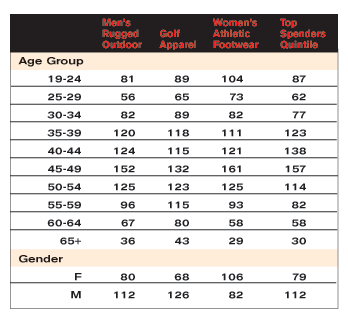This article is the third in a series that examines how each of several existing sales channels–retail, catalog, and the Internet—can create customer acquisition, retention, upsell, and cross-sell opportunities by leading to more-sophisticated multichannel marketing communications and greater connectivity among channels.
In the previous article of this series, https://www.multichannelmerchant.com/crosschannel/lists/point_sale2, we argued that consumer expectations for retailers are rising. To respond successfully, retailers of the future have to dovetail their products and services into a multichannel format, and they need to connect to the consumer using an increasing array of marketing communications to convey a sincere interest in a lifetime relationship. To that end, we examined how retail-centric organizations could use trade-area analysis to determine improved retail/catalog and retail/online strategies. In this article, we focus on how future multichannel marketing communications–combining direct, telemarketing, experiential, and interactive marketing methods–will present information to consumers in a more relevant format.
Back to the Future
A comment I frequently offer at speaking engagements is that our eventual goal for marketing must be to handle each and every customer through automated methods as if we were personally available to interact with each customer during each step of the decision-making and purchasing process. The customer relationship can be likened to a family relationship. Few people choose to communicate with family or friends by only one means of communication. By nature, when we seek to connect to those nearest to us, we write letters and we speak and we send packages and we provide e-mails. We choose the degree to which we speak, write, and send packages or e-mail based on the importance of the topic being addressed and on the ability/preference of the family members receiving the communications. For example, birthdays and holidays warrant packages, whereas fleeting thoughts might warrant e-mail. We may choose a fairly frequent flow of short e-mails to keep in touch with the business executive in our lives but choose to stage less frequent but longer communications by phone with retired parents, aunts, and uncles. The inevitable goal for marketing is to treat every customer like family and to recognize the particular nuances of working with each customer. Our goal is to arrange each interaction with our clients as if we were in the movie “The Matrix”–disciplining ourselves and our systems to provide repeatedly insightful, relevant, and sensitive individualized communications about just the right topic at just the right time to each member of our customer family.
Sample Application
An important first step to providing relevant communications to individuals within large-scale customer populations is to correctly identify who they are: where they come from, what type of household composition, their age and income, what books they read, what hobbies they enjoy… While there are several methods to ensuring you have this understanding, our clients have had success with a simple four-step “profiling” process:
1) Gather whatever customer data are available. 2) Clean the data.
3) Enhance the data with demographic and lifestyle information.
4) Construct indices—by major product lines and by recency/frequency/monetary value (RFM)–that indicate how your customer (or sets of customers) might be described relative to the public at large. A profile will quickly identify how your customers vary from the “man on the street” as well as distinguish how your customers in various product or value areas might vary from your customers in general. For example, the profile below conveys an overall 35-54 male sales target for a sporting goods chain, but counters trends associated with the store’s women’s footwear customer.

The example above depicts a profile using demographic descriptors. Profiles can as easily be arranged to score and index customers based on lifestyle and behavioral choices such as media preferences, Internet activity, and catalog usage. Often retailers will profile their customers against general commercial segmentation schemes such as PRIZM and MOSAIC to classify their targets according to types of neighborhoods.
Regardless of the content used in profiling, the purpose of the process is the same: to create a better understanding of who the customer is—the typical customer, the high spender, the buyer of specific products–and how he is best reached. Output from this task will help you ensure that customers receive relevant communications through the their preferred marketing channels tying directly to their interests, with messaging that they find appealing. The profiling exercise often links customers to a “messaging matrix,” such as shown below, so that the merchant can automatically deduce what personalized communications apply for their customers.

Profiling and the messaging matrix are basic tools that will help every merchant move toward more-relevant communications with their customers. Once you’ve embraced a multichannel strategy, you will find many other opportunities to leverage a fuller relationship with your customer. For example, the existence of an e-storefront not only creates a new point of sale but also provides customers an opportunity “to speak” to merchants about the local stores that had been their former point of sale. Cataloger/retailers can ensure that their print catalogs include maps that remind customers where to find their nearest stores. Brick-and-mortar stores can promote use of the Website and the catalog, particularly for items that are difficult to stock.
In this environment, opportunities for more frequent and deeper customer communication abound. The opportunities for more relevant and profound customer communications and analysis are immense.
Larry Daniel is president/CEO of Conclusive Strategies, an Austin, TX-based consultancy.

